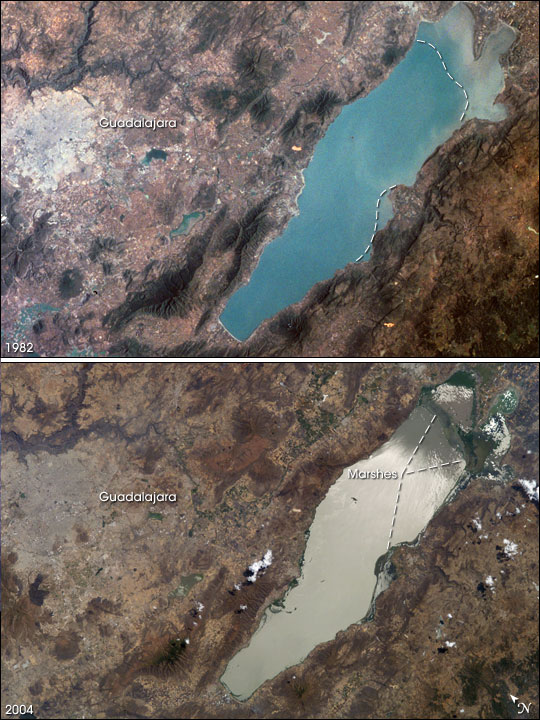


Astronauts aboard the Space Shuttle and Space Station have tracked regional environmental changes spanning decades. Lake Chapala, Mexico’s largest lake, serves as one example of an area experiencing significant changes that have been well documented from space. Over the past twenty years, the lake’s water levels have decreased in conjunction with increasing development from the fast-growing city of Guadalajara.
Chapala is an alpine lake in west-central Mexico, resting at an elevation of 1,500 meters. It is part of the Lerma-Santiago River system, being fed mainly by the Lerma River on the east side of the lake and draining into the Rio Grande de Santiago from the northeast corner of the lake. The water then flows northwest into the Pacific Ocean. The combined effects of diminished inflow from dams on the Rio Lerma, heavy use of water for irrigation, and regional droughts in recent years have resulted in lower water levels in the lake. This is important to humans because it is the major water source for the nearby city of Guadalajara and its five million residents. Today, the mean depth of Lake Chapala is approximately 7 meters, with seasonal variations of water depth and clarity.
The lake is also a critical habitat for several species of migratory birds, such as the white pelican, and home to thousands of indigenous plants and animals. Untreated industrial and agricultural runoff threaten the health of this critical lake. The rapid development of the Lake Chapala region has spurred grassroots conservation programs to maintain the natural habitats of the lake and maintain a healthy ecotourism industry.
This pair of images, one taken in November 1982 from the Space Shuttle and the other in April 2004 from the International Space Station, shows some of the coastline changes around the lake. In the 2004 image, sun glint reflecting off the water surface highlights the water-vegetation boundary of coastal marshes. These areas had actually become completely exposed and were being used by people for farming when the lake hit historic low levels in 2001 (see related story). The areas were re-innundated in 2003 after a season of above-average rains. Their estimated locations are annotated on the 1982 image as dashed lines—roughly following the boundary of more turbid water. The built-up area of Guadalajara has also expanded from the 1982 baseline.
Astronaut photograph STS005-37-758 was taken from the Space Shuttle in November 1982 using a Hasselblad medium format film camera equipped with a 100 mm lens. Photograph ISS009-E-5090 was acquired April 30, 2004 with a Kodak DCS760 digital camera with a 105 mm lens. The images are provided by the Earth Observations Laboratory, Johnson Space Center. The International Space Station Program supports the laboratory to help astronauts take pictures of Earth that will be of the greatest value to scientists and the public and to make those images freely available on the Internet. Additional images taken by astronauts and cosmonauts can be viewed at the NASA/JSC Gateway to Astronaut Photography of Earth.